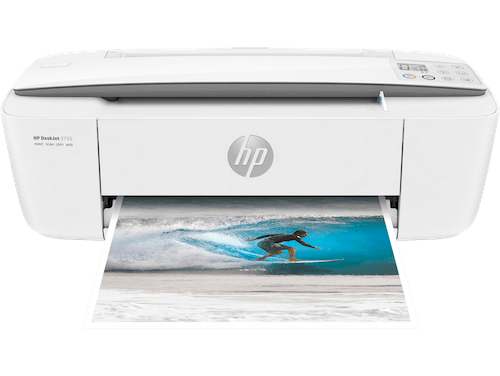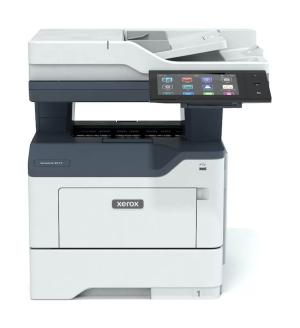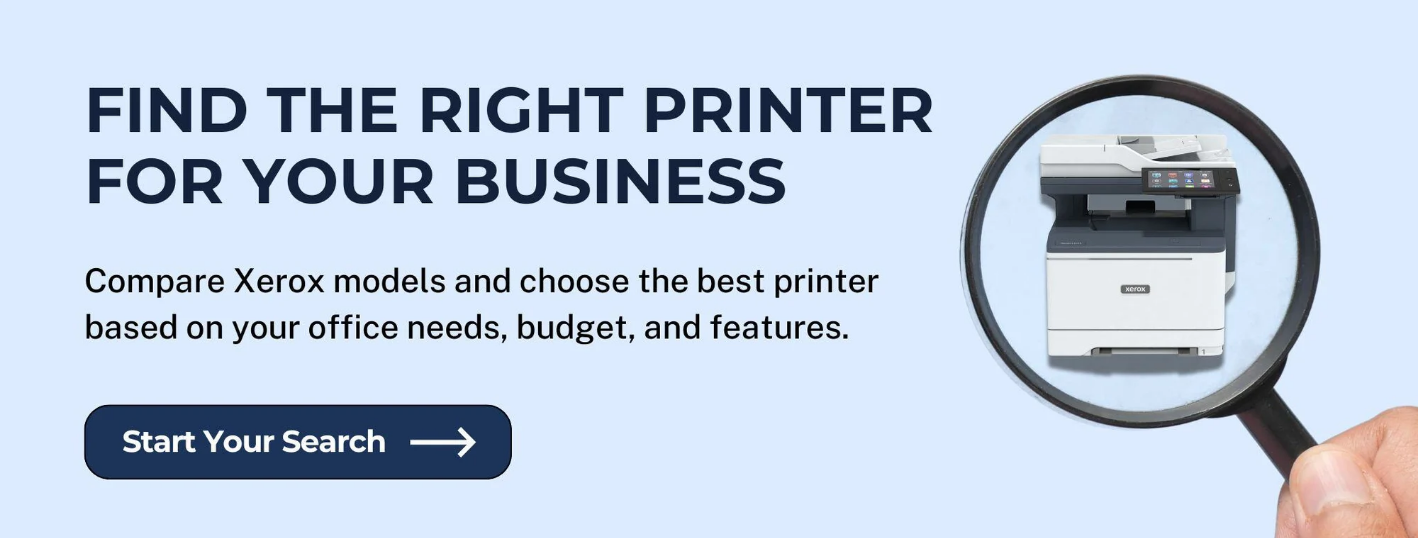What is the difference between an inkjet and a laser printer, and which is right for you? Are laser printers better than inkjet printers and vice versa?
These are the questions we will address in this blog. To choose the ideal printer for your printing needs, you must be well-informed about your options.
There are clear, significant differences between inkjet and laser printers. Before purchasing either, you must know these differences. Or else risk being stuck with an ill-equipped machine.
We’ve been a local print vendor for over 40 years and often get asked which type of printer is better for them. The truth is that the right printer type will vary depending on what your goals are.
In this blog, we'll rely on our expertise to provide you with all the information you need about laser and inkjet printers. We’ll compare the features of both printers, such as costs, print speeds, and print quality. This way, you will know which machine is better suited to your printing goals.
Here’s a quick summary:
- Inkjet printers use ink
- Laser printers use toner.
- Inkjets are ideal for personal/home use and printing high-quality photos
- Lasers are better for office use and printing text-heavy documents
Of course, there are other factors to consider when deciding, and we will go into them below.
Before you dive in, consider downloading our complete guide to purchasing or leasing a printer for your business to ensure you make the most informed buying decision.
Let’s begin with the basics: What is an inkjet printer, and how does it work?
What Is an Inkjet Printer?
Inkjet printers are small, usually cheaper machines that spray liquid ink onto paper and dry naturally. Inkjet printer ink is traditionally made of carbon pigments, drying agents, and other components that help the ink bind to printer paper.
On the other hand, a laser printer uses heat to melt toner powder onto paper to create a print.
Inkjet printers are mainly designed for personal use and are commonly used as home printers.
Several inkjet printer models, including the traditional printer style, are available on the market.
Photo inkjet printers are popular among consumers who need to print high-quality images. These printers are designed to print photos or images with exceptional accuracy and precision.
If you’re printing in color, photo inkjet printers will deliver the best print quality/print resolution.
Inkjet printers have their pros and cons. It’s essential to review them before discussing laser printers.
2 Pros of Inkjet Printers
Here are two primary pros to inkjet printers:
1. More Affordable Short-Term Cost
The clear advantage of inkjet printers over laser printers is that they tend to be cheaper for consumers.
This is precisely why they are an attractive choice for people who need a basic printer that gets the job done. Examples of inkjet printers and their prices include:
- HP DeskJet 3755 is currently listed at $74.99 on HP’s website.
- Canon PIXMA TR 4720 is currently listed at $79.99 on Best Buy’s website.
- Brother MFC-J1170DW is currently listed at $129.99 on Brother’s website.
Inkjet printers tend to be more readily available than laser printers. You can typically find inkjet printers at large retail stores like Staples, Walmart, and Best Buy.
The HP DeskJet 3755 inkjet printer, courtesy of HP:

2. Smaller in Size
Another advantage of inkjet printers over laser printers is that they are usually smaller in size and cheaper.
This means an inkjet printer can better fit into a compact workspace like a home office or small business.
For example, the HP DeskJet 3755 listed above has base model dimensions of 15.86” x 6.97” x 5.55” and weighs only five pounds.
2 Cons of Inkjet Printers
Now that you’ve seen the positives, let’s go over the negatives when it comes to inkjet printers:
1. Can Be Costly to Maintain
Although an inkjet printer might be cheaper initially, it can be more expensive to maintain in the long run versus a laser printer.
The cost to maintain an inkjet printer can quickly add up for a few reasons:
► Inkjet printers typically have a high cost per page.
This is how much you pay per print/copy based on how many pages your toner (or ink) cartridge produces before running out. The cost per page depends on how much ink is put on the pages (more on this later). Read our guide on how to calculate your printing cost per page here.
► An inkjet printer usually runs out of ink quicker than a laser printer runs out of toner.
Ink for inkjet printers can cost anywhere from $20 to $120, depending on the brand of ink and how much ink is in the package. This is cheaper on average than toner cartridges, which range in price from $60 to $400.
Although it’s cheaper to buy ink than toner, some ink cartridges only last 400 pages before they run out. In contrast, toner cartridges last longer. One toner cartridge can last up to 7,000 pages or more.
So, while toner is more expensive than ink upfront, buying ink cartridges will likely cost you more in the long run if you use your printer regularly. You will have to purchase new ink cartridges more often as they don't last as long as toner cartdiges.
► If your inkjet printer needs service and you’re not under a maintenance contract, you’ll have to outsource service work for the machine.
This can be challenging to find because many technicians don’t work on inkjet printers. You will likely have to replace the machine if your printer has service issues.
Inkjet printers are great for personal at-home use or for printing high-quality photos. However, the cost of maintaining an inkjet printer can add up quickly if you don't use it often.
2. Shorter Lifespan
Another notable downside to inkjet printers is that they typically won’t last more than three years if used at an "average volume."
Inkjet printers are generally cheaper to build and are not designed to last as long as laser printers are. This means they are made for the short term and shouldn’t be relied on as a permanent printing solution for an office or large business setting.
Is an Inkjet Printer Right for You?
If you’re in the market for a personal printer to use on an as-needed basis or need to print high-quality color photos, then you are an ideal candidate for an inkjet printer.
If you don’t meet the above criteria, you will likely not be a fit for an inkjet printer and will need to look at a laser printing option.
But what exactly is a laser printer? And what are its pros and cons?
Here is a visual comparison of the pros and cons of inkjet and laser printers, courtesy of LD Products:
%20Inkjet%20vs%20Laser%20graphic%20comparison%20copy_650.jpeg)
What Is a Laser Printer?
Laser printers are big and durable, commonly viewed as “traditional office printers.”
Laser printers use electrical currents to attract toner “dust” to a drum. Then, the drum applies the toner to a piece of paper, where it gets fused with heat. When it comes to the supplies each machine uses, you can think of laser and inkjet printers like this:
Laser printers = Toner
Inkjet printers = Ink
How long does toner typically last? Learn about toner longevity here.
Because laser printers are manufactured to serve office and business settings, they typically print at a higher volume and faster print speeds than inkjet printers.
If you plan to print many documents frequently, laser printers are the way to go.
So, what are the advantages and disadvantages of buying a laser printer? Let’s break these down in more detail:
2 Pros of Laser Printers
Let’s first take a look at the main advantages of purchasing a laser printer:
Built as a Permanent Printing Solution
The main advantage of laser printers is their longevity in your office. They can last up to five years or more, depending on your print volume and model.
That’s why they are the best choice for companies that need to print or copy a large volume of documents daily; they will last a long time if you follow your machine’s recommended monthly print volume.
Read our blog on the importance of recommended monthly print volume to learn more.
In the long run, laser printers are also cheaper to maintain and more cost-effective as toner cartridges last longer, which means you'll have a lower cost-per-page.
Faster Print Speed and Higher Print Quality
Another significant advantage of laser printers is that they have faster print speeds and produce higher-quality text-based document prints than inkjet printers.
For example, the Xerox VersaLink B415, a laser printer, prints at speeds of up to 50 pages per minute (ppm). Meanwhile, the HP DeskJet 3755, an inkjet printer, only prints up to 8 ppm.
When it comes to printing colored images, inkjet printers are better. But, for any print with text, a laser printer will almost always produce better quality.
Furthermore, prints from inkjet printers can sometimes smear and take longer to dry than those from laser printers, which don't require any drying time.
And ink cartridges can dry out if you don’t use them regularly. That means you might have to buy new ink when printing something important.
2 Cons of Laser Printers
Now that we’ve gone over the pros, let’s dive into the main disadvantages of laser printers:
More Expensive Short-Term Cost
Laser printers can be more expensive upfront than inkjet printers because of their higher print volume capacity and print speed. Examples of laser printers and their prices include:
- Xerox VersaLink B415 is currently listed at $1,399, according to their website.
- HP LaserJet M776zs is currently listed at $8,359 on HP's website.
- Ricoh IM C3000 is currently listed at $5,008.08, according to A Matter of Fax.
While laser printers may cost more initially, they are cheaper to maintain than an inkjet printers. This is because in the long run, they can handle larger volumes of documents and require less supplies.
To offset the expensive initial cost of buying a new printer, many businesses lease their machine rather than purchase it.
Read our blog on leasing vs. purchasing a printer to learn more about the two options.
Xerox VersaLink B415, courtesy of Xerox:

The Ricoh IM C3000 laser printer, courtesy of Ricoh:

They Are Large Machines
Another downside to laser printers is that they can be much bigger than inkjet printers and require more space to accommodate the machine.
However, this is not always the case, as laser printers can be smaller desktop machines, like the Xerox VersaLink B415 pictured above.
More advanced all-in-one printers, such as the Xerox AltaLink C8270, have base dimensions of 24.4” x 31.2” x 46” and a weight of 352 lbs. These can be challenging to fit into crowded office areas or home offices.
Consider a printer’s space and electrical requirements before purchasing to ensure you don’t buy one that can’t reasonably fit into your workspace.
Inkjet Printer vs. Laser: Is a Laser Printer Right for You?
If you need a printer for your office or business that can efficiently/quickly print and copy a high volume of documents, a laser printer is the best option. It will last you a longer time and cost less per page.
While not always the case, think of inkjet and laser printers like this:
Inkjet = Personal printers
Laser = Office printers
Which Printer Brand Should You Buy From?
Inkjet and laser printers are the two most common types on the market.
Inkjet printers are best suited for personal use or printing high-quality photos/images, while laser printers are more suitable for office settings and regular high-volume document printing.
The type of printer you choose will also depend on your budget, long-term printing goals, and print requirements.
After learning about the differences between laser and inkjet printers, the next step is to decide which brand to buy.
There are many options available, and choosing the printer you want and who to purchase it from is vital to getting the right machine in place for your company.
Check out our blog post on the top five printer brands to help you decide which one to choose when purchasing a new machine.
Or, if you’re ready to choose a printer, head to our Shop Now tab or click on the image below to try our product configurator tool. You can filter for printer specifications such as print speed, price point, and paper size, and get results that best match your needs.

